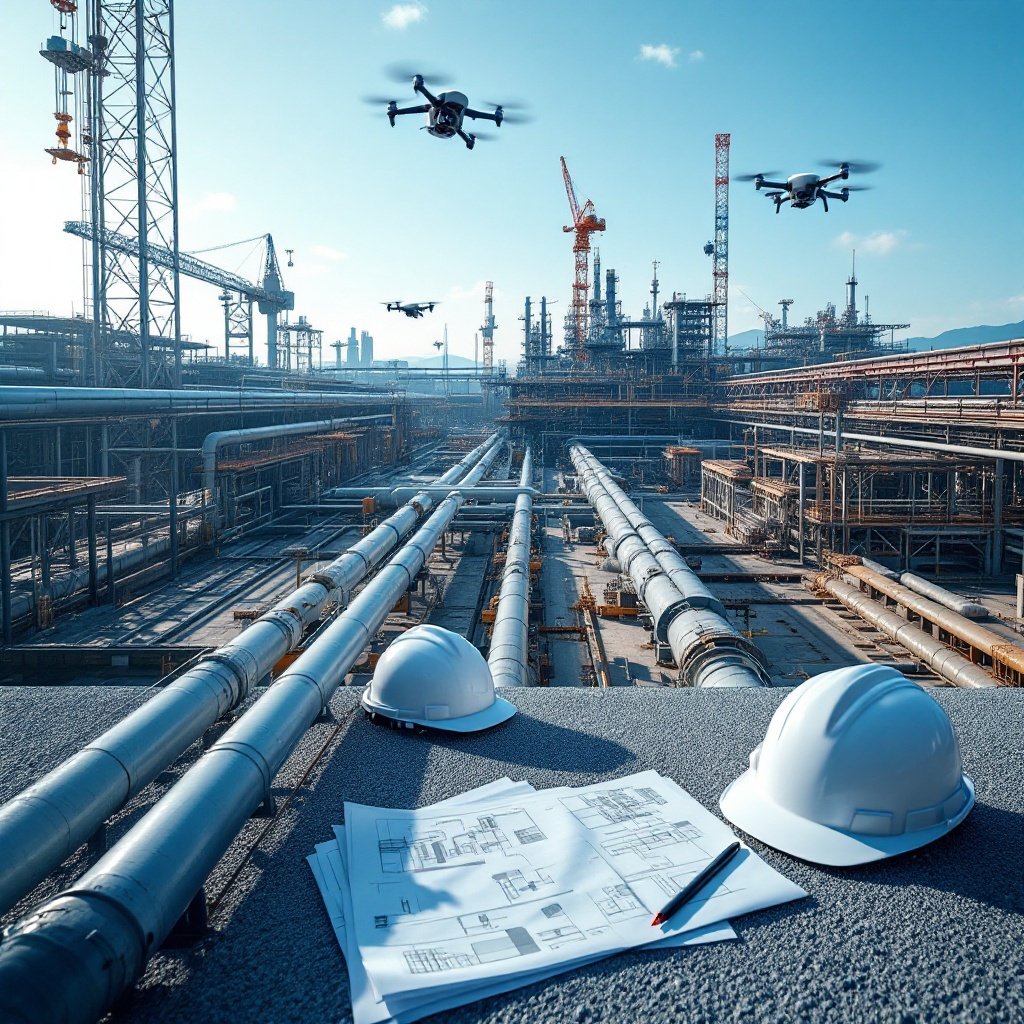Drones in EPC Projects: Revolutionizing Inspections with AI and IoT 🚁💡

Home Solutions Leadership Success Stories Our Journey Insights Reach Out Home Solutions Leadership Success Stories Our Journey Insights Reach Out Drones in EPC Projects: Revolutionizing Inspections with AI and IoT 🚁💡 Drones are revolutionizing EPC projects through faster, safer, and cost-effective inspections. Central to this evolution are smart devices — AI- and IoT-enabled machines that provide a steady stream of real-time data, predictive maintenance and enhanced decision-making. This article explores advantages, issues, and practical benefits and how drones are changing the way infrastructure is monitored, including oil, gas, and power. Surely, EPC projects work on large scale infrastructure such as oil refiner, power plant, industrial facility, and much more that requires repetition process inspections to be safe and compliant. And it’s not possible to do it by hand: traditional approaches — like on-foot inspections or a helicopter survey — are laborious, dangerous and costly. This is where drone technology (unmanned aerial vehicles (UAVs)) equipped with sophisticated sensors, cameras, and AI algorithms are revolutionizing the way EPC companies monitor and manage projects. The incorporation of AI into IoT (Internet of Things) solutions further enhances this shift, allowing organizations to collect data in real time and leverage predictive analytics and automated reporting. However, challenges such as regulatory compliance and data security persist. This article aims at further exploring the pros and cons of drone adoption, the role of AI and IoT in it, and then, some real-world examples to understand them better. Benefits of Drones in EPC Inspections 🔍 1. Enhanced Safety: It also means workers never have to shimmy to rickety heights or crawl into cramped quarters. Some oil refineries, for example, can tell you at any given moment in time where their flare stacks are located, cutting the chance of an injury to a very small number. BP, for instance, has claimed that drone inspections in 2019 helped decrease safety incidents on its offshore platforms by 40 percent. ⏱️ 2. Time and Cost Efficiency: For example, instead of days it takes you hours for drones to survey a 100acre solar plant. Shell has said it reduced inspection costs by up to 30 percent and is employing drones for inspecting offshore facilities. Drones, for instance, can cover a large area in a shorter amount of time, and don’t need scaffolding or heavy equipment. 📊 3. High-Quality Data: LiDAR mounts on drones provide centimeter-accurate 3D maps. It allows for early detection of pipeline corrosion or structural defects. Chevron, for instance, uses drones to create detailed three-dimensional models of their refineries, enabling engineers to identify potential issues before they manifest. 🌐 4. IoT Integration: IoT Sensors Synced with Drones0597While the drones deliver material wherever needed yeah can be overlaid with e.g., IoT sensors able to provide live feedback on the temperature, vibration, or gas leak installations. For instance, Siemens uses drones enabled with IoT to supervise the status of wind turbines. Such UAVs are able to detect anomalies in real time, enabling timely corrective actions. 🌍 5. Environmental Benefits: Drone manufacturers say this minimizes the carbon footprint of inspections, which are usually done by helicopter or vehicle. A PwC study found that, drone inspections can save CO2 emissions by 50%, compared to traditional methods. Challenges of Drone Adoption ⚠️ 1. Regulatory Hurdles: The strictness of aviation laws (like FAA Part 107 in the U.S.) require certification and restrict zones of flight and this holds back deployments. It can take weeks or even months to secure permits to operate a drone in industrial areas in some countries. 💻 2. Data Overload: Drones produce terabytes of data. It can be tedious to process all this information without using AI-driven analytics. This means that large corporations should have a strong data management systems in place to store analyse and interpret the large amounts of data they col Biotech companies. 🔒 3. Cybersecurity Risks: And hackers can track sensitive project data being transmitted by drones or IoT devices. This is especially valuable for projects that work with classified or proprietary data. 💰 4. Initial Investment Costs: While drones can reduce long-run costs, the immediate outlay for high-quality drones, sensors, and software can be significant. Justification for these advance costs may become difficult for small and medium-sized EPC companies. AI and IoT: Supercharging Drone Capabilities 🤖 1. AI-Powered Analytics: Drone footage is analyzed by machine learning algorithms to spot cracks and leaks, or equipment wear. As an example, BP is using AI to predict 95% of pipeline failures. AI is also being more and more used to help to automate the process of identifying defects, giving the organization less dependence on human inspection. 📡 2. IoT Connectivity: Drones are providing real-time data to localized dashboards. Bechtel extracts drone data into their BIM ( Building Information Modeling ) system for clash detection, for example. The IoT-enabled drones can further work in communication with other smart devices on the site, facilitating the seamless information flow. 🌧️ 3. Predictive Maintenance: AI models learn historical and real-time data to predict equipment breakdowns. This was used to reduce downtime by 20% at Dow Chemical. Predictive maintenance reduces cost and increases the longevity of critical infrastructure. 📈 4. Automated Reporting: Automatic generation of detailed inspection reports, minimizing human error and saving time. The outputs of such reports can be annotated images, 3D models, as well as advice for remediation. Real-World Examples ✅ Case Study 1: ExxonMobil ExxonMobil sent up drones with thermal cameras to scan offshore rigs. Outcome: 50% Faster Inspections, and 25% Reduction in Operational Downtime. The drones also identified potential problems that the original manual inspections had missed. ✅ Case Study 2: Fluor Corporation A LNG plant construction site monitored using drones trained by AI by Fluor. The integration with IoT allowed automatic updates via cloud platforms for our project managers. As a result, this reduced delays in the project by 15% and enhanced the overall efficiency. ✅ Case Study 3: Shell Shell rolled out drones to inspect their offshore platforms. The drones were fitted with high-tech sensors that could find corrosion and other structural damage. The initiative led to a 30 percent reduction in inspection costs and a marked improvement in safety. ✅ Case Study 4: Chevron Chevron then creates accurate 3D models of their refineries using drones. These models allow engineers to identify potential issues before they become problems. Drone technology led to a 20%
🚀 The Transformative Power of AR and VR in Engineering Education and Project Management 🌐

Home Solutions Leadership Success Stories Our Journey Insights Reach Out Home Solutions Leadership Success Stories Our Journey Insights Reach Out 🚀 The Transformative Power of AR and VR in Engineering Education and Project Management 🌐 Artificial Reality Framework (AR) and Augmented Reality (AR) are revolutionising engineering teaching and implementation by allowing immersive real time collaboration between architects designers and technical aspects to achieve error free implementation. Integrating proven technologies like IoT and blockchain as well as modern technologies like digital twins and robotics can help EPC experts translate their theoretical knowledge into practical applications, delivering efficiency and innovation across EPC projects. In order to stay ahead in the fast-evolving world of engineering, procurement and construction (EPC), we must pick up and adapt new generation tools. While Traditional educational practices are taking a backseat, the new Augmented Reality (AR) and Virtual Reality (VR) technologies have proven to be game-changers in the engineering world, revolutionizing how engineers learn, function, and work on complex projects. Be it immersive training simulations or 3D visualizations of the design stage of a project, AR and VR provide enhanced decision-making, lowered costs, and reduced risks. In this article, we will discuss these AIs, their uses in two industries — engineering education and project management, along with case studies and practical advice for EPC companies willing to step into the future. 🔍 1. AR vs VR: What You Need to Know AR (Augmented Reality): Adds digital information to the physical world (e.g., holographic instructions on machinery). For example, Microsoft HoloLens used for equipment field6 solution. VR (Virtual Reality): Puts the user in an all-digital environment (e.g., virtual walkthrough of construction site). For instance: Safety protocols training for oil refineries with STRIVR VR. 🎓 2. Engineering Education in AR/VR A. Immersive Training Simulations It is possible to carry out high-risk tasks (like electrical grid maintenance) without introducing any risk to the environment with VR. Case Study: VR Training For Siemens Gas Turbine Assembly: 40 Percent Faster (Siemens Report 2023). B. Interactive 3D Models AR apps that allow students to virtually dissect machinery at Augment improve understanding of complex systems. Key Benefits: ✅ Skill acquisition is 70% faster (PwC Study) ✅ 30% lower training expenses. 🏗️ 3. Augmented Reality and Virtual Reality in Engineering Project Management A. Real-Time Collaboration And, platforms such as Trimble Connect leverage AR to visualize BIM models at construction sites, allowing stakeholders to detect clashes prior to implementation. B. Remote Site Inspections With VR headsets, project managers can have virtual site visits and save both time and travel costs. Case Study: Bechtel used VR tooling to inspect a nuclear plant and reduced inspection time by half (Bechtel Case Study, 2022). C. Risk Mitigation AR-enabled smart helmets (like DAQRI) can warn workers about hazards in real time, reducing onsite accidents by as much as 25%. Key Benefits: ✅ Projects delivered 20% faster. ✅ 15% cost reduction via error elimination. 🌐 4. EPC in the Realtime World Oil & Gas AR: BP employs AR spectacles to direct technicians in pipeline repairs, increasing accuracy by 34% (BP Innovation, 2021) Virtual Reality (VR) in Infrastructure: The HS2 railway has been modeled in VR to alter alignments and gain stakeholder buy in (AECOM) 🚧 5. Challenges and Solutions Initial Costs: Collaborate with AR/VR startups to build scalable solutions. Data Security: Use encrypted platforms (e.g., Unity Reflect) User Adoption: Run pilot programs to show ROI. 📈 Conclusion AR and VR are not only buzzwords of the future — they are applicable tools transforming EPC workflows today. Integrating these technologies that empower training results, improve project workflow, and are competitive-minded to those the company works with. The combined physical and digital world is the future of engineering, and it is time to get going. 📚 References & Sources Siemens VR Training Report, 2023 Bechtel VR Case Study, 2022 BP AR Innovation, 2021 PwC, “The ROI of VR Training,” 2022. STRIVR, “VR in Industrial Training,” 2023. Apces Co. – Leading the way in innovative engineering, procurement, and construction services. Building a sustainable future with precision and excellence. © 2024 Apces Co. All rights reserved. Unauthorized use or reproduction is prohibited. Links Solutions Leadership Success Stories Our Journey Insights Support Get In Touch Privacy Policy Contacts (+98) 1234567896th NarenjestanPasdaran, Tehran, Iran
The Impact of Building Information Modeling (BIM) on EPC Projects: Benefits, Challenges, and Success Stories 🏗️💻

Home Solutions Leadership Success Stories Our Journey Insights Reach Out Home Solutions Leadership Success Stories Our Journey Insights Reach Out The Impact of Building Information Modeling (BIM) on EPC Projects: Benefits, Challenges, and Success Stories 🏗️💻 Building Information Modeling (BIM) is revolutionizing Engineering, Procurement, and Construction (EPC) projects by enhancing collaboration, reducing costs, and improving project outcomes. This article explores the transformative role of BIM in EPC projects, highlighting its benefits, challenges, and real-world success stories. In the fast-evolving world of construction and engineering, EPC projects are becoming increasingly complex, requiring seamless coordination among multiple stakeholders. Building Information Modeling (BIM) has emerged as a game-changer, offering a digital framework that integrates design, construction, and operational data into a unified model. By leveraging BIM, EPC projects can achieve better visualization, improved communication, and enhanced decision-making. However, the adoption of BIM is not without challenges, including technical barriers and organizational resistance. This article delves into the advantages of BIM in EPC projects, examines the hurdles to its implementation, and showcases successful case studies that demonstrate its transformative potential. The Role of BIM in EPC Projects 1. Enhanced Visualization and Planning 🖼️ BIM provides a 3D digital representation of the project, enabling stakeholders to visualize construction activities and identify potential conflicts before they occur. This proactive approach reduces rework and ensures smoother project execution. 2. Improved Collaboration and Communication 🤝 BIM fosters collaboration among architects, engineers, contractors, and facility managers by providing a centralized platform for data sharing. This reduces miscommunication and ensures that all stakeholders are working from the same information. 3. Cost and Time Efficiency ⏳💰 By integrating 4D (time) and 5D (cost) dimensions, BIM allows for accurate cost estimation and scheduling. This minimizes budget overruns and delays, making EPC projects more financially viable. 4. Risk Mitigation and Quality Control 🛠️ BIM’s clash detection and simulation capabilities enable early identification of risks, ensuring higher quality and compliance with project standards. Challenges in Implementing BIM in EPC Projects 1. Technical Barriers 🖥️ The integration of BIM requires advanced software and hardware, which can be costly and complex to implement. 2. Organizational Resistance 🚧 Adopting BIM often requires a cultural shift within organizations, which can be met with resistance from employees accustomed to traditional methods. 3. Data Management Issues 📊 Effective BIM implementation relies on robust data management systems. Poor data handling can lead to inconsistencies and errors, undermining the benefits of BIM. 4. Lack of Standardization 📏 The absence of universal standards for BIM adoption can create interoperability issues, making it difficult to share data across different platforms. Success Stories: BIM in Action Case Study: BIM in Chinese EPC Projects 🇨🇳 A study on BIM adoption in China highlighted significant improvements in cost and time performance. By integrating BIM with other digital technologies, Chinese EPC projects achieved better resource allocation and reduced delays. Case Study: BIM in Saudi Arabia’s Vision 2030 🇸🇦 Saudi Arabia’s ambitious Vision 2030 initiative has seen the successful implementation of BIM in mega-construction projects. BIM’s ability to streamline workflows and enhance collaboration has been instrumental in meeting project deadlines and budgets. Case Study: BIM in Hospital Construction 🇺🇸 A hospital construction project in the United States utilized BIM to improve safety and efficiency. The project team used BIM to simulate construction processes, identify potential risks, and optimize resource allocation, resulting in a 20% reduction in project duration. Conclusion 🎯 Building Information Modeling (BIM) is transforming EPC projects by enhancing visualization, improving collaboration, and reducing costs. While challenges such as technical barriers and organizational resistance persist, the benefits of BIM far outweigh the hurdles. Successful case studies from China, Saudi Arabia, and the United States demonstrate the transformative potential of BIM in achieving project excellence. As the construction industry continues to evolve, the adoption of BIM will be crucial for staying competitive and delivering high-quality projects. References Piselia, M. (2020). 4D BIM implementation to improve EPC project performance from contractor’s perspective. IOP Conference Series: Materials Science and Engineering, 930, 012011. Link Analysis of Improvement of BIM-Based Digitalization in Engineering, Procurement, and Construction (EPC) Projects in China. MDPI. Link Blueprint for progress: Understanding the driving forces of BIM adoption in Kingdom of Saudi Arabia (KSA) construction industry. PLOS ONE. Link Exploring the Challenges in Building Information Modeling (BIM) During the Design Phase. IEEE Xplore. Link Sustainability and Stakeholder Engagement in Building Information Modelling-Enabled Construction. MDPI. Link Unlocking Efficiency: A Case Study on BIM Integration Data Management in Construction Projects. UW Pressbooks. Link Apces Co. – Leading the way in innovative engineering, procurement, and construction services. Building a sustainable future with precision and excellence. © 2024 Apces Co. All rights reserved. Unauthorized use or reproduction is prohibited. Links Solutions Leadership Success Stories Our Journey Insights Support Get In Touch Privacy Policy Contacts (+98) 1234567896th NarenjestanPasdaran, Tehran, Iran
🚀 Digital Transformation in the EPC Industry: Revolutionizing Project Management Software, Common Challenges, and Solutions 🌐

Home Solutions Leadership Success Stories Our Journey Insights Reach Out Home Solutions Leadership Success Stories Our Journey Insights Reach Out Digital Transformation in the EPC Industry: Revolutionizing Project Management Software, Common Challenges, and Solutions The EPC (Engineering, Procurement, and Construction) industry is undergoing a seismic shift driven by digital transformation. Emerging technologies like AI, IoT, and cloud-based project management software are addressing chronic challenges such as cost overruns, delays, and fragmented communication. This article explores how digital tools like CADMATIC Projects™, Oracle Primavera, and AI-driven platforms are streamlining workflows, enhancing collaboration, and mitigating risks. Real-world examples, such as India’s hydrogen purification project and Nuberg Engineering’s digital twin implementations, highlight the tangible benefits of this evolution [4][5][12] The EPC sector, responsible for delivering complex infrastructure projects, faces mounting pressure to adopt digital solutions. Traditional methods, reliant on manual processes and siloed systems, struggle with inefficiencies: 40% of mega projects exceed budgets by 10% or more, while labor shortages and sustainability mandates compound these challenges [7][8]. Digital transformation offers a lifeline, integrating advanced software and technologies to optimize project lifecycle management. From predictive analytics to 3D modeling, this article delves into how EPC firms can harness digital tools to overcome obstacles and thrive in a competitive landscape. The Role of Project Management Software in EPC Digital Transformation 1. Addressing Common Challenges Project Delays and Cost OverrunsEPC projects are notorious for delays due to poor communication, supply chain disruptions, and scope creep. Tools like Oracle Primavera P6 and CADMATIC Projects™ integrate 3D modeling with real-time progress tracking, enabling managers to identify bottlenecks early and adjust schedules dynamically. For example, CADMATIC’s visualization tools reduced rework by 52% in oil and gas projects by improving stakeholder alignment [7]. Fragmented CommunicationWith stakeholders spanning continents, cloud-based platforms like Bluebeam and Autodesk BIM 360 centralize data, ensuring all parties access updated designs and documents. This reduces miscommunication, a factor in 35% of non-optimal work hours [8]. Risk ManagementAI-driven platforms analyze historical data to predict risks like equipment failures or weather disruptions. For instance, predictive maintenance in Nuberg Engineering’s projects cut downtime by 20% using IoT sensors [5][12]. 2. Key Software Solutions and Their Impact CADMATIC Projects™Integrates with Primavera to visualize project progress through 3D models, enabling early warnings for delays and budget deviations [7]. AI-Powered PlatformsMachine learning algorithms optimize resource allocation and automate bid evaluations, as seen in Deloitte’s survey, where AI reduced engineering hours by 10–30% [9]. Digital TwinsVirtual replicas of physical assets, like those used in IOCL’s Bio-Ethanol Plant, allow real-time simulation and design adjustments, slashing commissioning time by 15% [4][12]. Overcoming Obstacles: Best Practices 1. Adopt Phased Implementation Start with pilot projects (e.g., cloud-based collaboration tools) to demonstrate quick wins before scaling [4][15]. 2. Upskill Workforce Invest in training programs to bridge the digital skills gap, focusing on data analytics and IoT [5][11]. 3. Leverage Partnerships Collaborate with tech providers like Aurigo Software (developer of Bathydrone for underwater surveys) to access specialized expertise [6][8]. 4. Prioritize Cybersecurity As digitization expands, embed security protocols into software architectures to protect sensitive project data [6]. Conclusion 🎯 Digital transformation is no longer optional for EPC firms—it’s a strategic imperative. By leveraging project management software, AI, and collaborative platforms, companies can tackle delays, reduce costs, and enhance sustainability. Success stories like Nuberg Engineering’s zero-accident record and India’s hydrogen facility underscore the transformative power of these tools. The future belongs to firms that embrace agility, innovation, and data-driven decision-making. References and Sources 📚 Digital Transformation in the EPC Industry – Arundo [3] The Role of Digital Transformation in EPC – YourStory [4] Nuberg EPC’s Digital Journey [5][12] 7 Tech Trends Reshaping Construction – Forbes [6] Efficiency Challenges in EPC Project Management – Cadmatic [7] 6 Critical Construction Challenges in 2025 – MyCNR [8] Drivers of EPC Digital Transformation – What Is Piping [9] Apces Co. – Leading the way in innovative engineering, procurement, and construction services. Building a sustainable future with precision and excellence. © 2024 Apces Co. All rights reserved. Unauthorized use or reproduction is prohibited. Links Solutions Leadership Success Stories Our Journey Insights Support Get In Touch Privacy Policy Contacts (+98) 1234567896th NarenjestanPasdaran, Tehran, Iran
The Procurement Phase in EPC Projects: Challenges, Solutions, and Best Practices 🛠️📦

Home Solutions Leadership Success Stories Our Journey Insights Reach Out Home Solutions Leadership Success Stories Our Journey Insights Reach Out The Procurement Phase in EPC Projects: Challenges, Solutions, and Best Practices The procurement phase in Engineering, Procurement, and Construction (EPC) projects is a critical stage that ensures the timely and cost-effective acquisition of materials and equipment necessary for project execution. This phase involves sourcing, purchasing, and delivering high-quality materials and equipment while adhering to project timelines and budgets. However, it is often fraught with challenges such as supply chain disruptions, quality issues, and logistical complexities. This article delves into the procurement process, common problems, and effective solutions to ensure smooth project execution. In the realm of EPC projects, the procurement phase is a cornerstone that bridges the gap between engineering design and construction. It encompasses the acquisition of all materials, equipment, and services required to bring the project to life. The procurement process is not merely about purchasing; it involves meticulous planning, supplier management, quality assurance, and logistics coordination. Given the complexity and scale of EPC projects, the procurement phase is often susceptible to various challenges, including supply chain disruptions, price volatility, and compliance issues. These challenges can lead to project delays, cost overruns, and even compromise the quality of the final deliverable. Therefore, understanding the intricacies of the procurement process, identifying potential pitfalls, and implementing robust solutions are essential for the successful execution of EPC projects. This article provides a comprehensive overview of the procurement phase in EPC projects, highlighting common challenges and offering practical solutions. By leveraging best practices and real-world examples, we aim to equip project managers and procurement professionals with the knowledge and tools needed to navigate this critical phase effectively. The Procurement Process in EPC Projects 🔄 1. Planning and Specification Development Clearly outlining the materials and equipment needed based on the project’s engineering design. Defining Requirements:Clearly outlining the materials and equipment needed based on the project’s engineering design. Budgeting:Estimating costs and setting a procurement budget. Timeline Development:Establishing a procurement schedule that aligns with the overall project timeline. Example: In a power plant EPC project, the procurement team must specify the type and quantity of turbines, generators, and transformers required, along with their technical specifications. 2. Supplier Selection and Contracting Selecting the right suppliers is crucial for ensuring quality and timely delivery. This stage involves: Supplier Evaluation:Assessing potential suppliers based on criteria such as quality, cost, delivery time, and past performance. Request for Proposals (RFP):Issuing RFPs to shortlisted suppliers and evaluating their proposals. Contract Negotiation:Finalizing contracts that outline terms and conditions, including delivery schedules, payment terms, and quality standards. Example: In an oil and gas EPC project, the procurement team may evaluate multiple suppliers for pipeline materials, considering factors such as material grade, corrosion resistance, and supplier reliability. 3. Order Placement and Expediting Once contracts are in place, the next step is to place orders and monitor their progress: Order Placement:Issuing purchase orders to suppliers. Expediting:Tracking the progress of orders to ensure they are on schedule and addressing any delays or issues that arise. Example: In a refinery project, the procurement team may expedite the delivery of critical equipment like heat exchangers to avoid construction delays. 4. Quality Assurance and Inspection Ensuring the quality of materials and equipment is paramount. This stage involves: Inspection:Conducting inspections at various stages, including pre-shipment and post-delivery, to verify compliance with specifications. Testing:Performing tests to ensure materials and equipment meet required standards. Example: In a petrochemical project, the procurement team may inspect and test pressure vessels to ensure they meet safety and performance standards. 5. Logistics and Transportation Efficient logistics and transportation are essential for timely delivery: Transportation Planning:Coordinating the transportation of materials and equipment from suppliers to the project site. Customs Clearance:Handling customs procedures for international shipments. Site Delivery:Ensuring materials and equipment are delivered to the correct location within the project site. Example: In a cross-border pipeline project, the procurement team must navigate complex customs regulations to ensure the timely delivery of pipeline sections. 6. Inventory Management and Storage Proper inventory management and storage are critical to avoid delays and damage: Inventory Tracking:Maintaining an accurate inventory of materials and equipment. Storage:Ensuring materials and equipment are stored properly to prevent damage or deterioration. Example: In a large-scale construction project, the procurement team may use a warehouse management system to track and store construction materials like steel beams and concrete. Common Challenges in the Procurement Phase 🚨 1. Supply Chain Disruptions Supply chain disruptions, such as delays in raw material supply or transportation issues, can significantly impact project timelines. Solution: Diversify the supplier base and establish contingency plans to mitigate the impact of disruptions. 2. Quality Issues Quality issues with materials or equipment can lead to rework, delays, and increased costs. Solution: Implement rigorous quality assurance processes and conduct regular inspections and testing. 3. Price Volatility Fluctuations in material prices can affect the project budget. Solution: Use fixed-price contracts or hedging strategies to manage price risks. 4. Logistical Challenges Logistical challenges, such as transportation delays or customs issues, can hinder the timely delivery of materials and equipment. Solution: Work with experienced logistics providers and ensure proper documentation for customs clearance. 5. Compliance and Regulatory Issues Non-compliance with regulatory requirements can result in fines, delays, and reputational damage. Solution: Stay updated on regulatory changes and ensure all materials and equipment comply with relevant standards. Best Practices for Effective Procurement in EPC Projects 🏆 1. Early Involvement of Procurement Teams Involving procurement teams early in the project planning phase ensures that procurement considerations are integrated into the project design and schedule. 2. Supplier Relationship Management Building strong relationships with suppliers can lead to better pricing, improved quality, and more reliable delivery. 3. Use of Technology Leveraging procurement software and tools can enhance efficiency, improve tracking, and provide real-time data for decision-making. 4. Risk Management Identifying potential risks and developing mitigation strategies can help minimize the impact of disruptions. 5. Continuous Improvement Regularly reviewing and improving procurement processes based on lessons learned from previous projects can lead to better outcomes. Conclusion 🎯 The procurement
Unlocking the Future: The Importance and Application of the Latest Technologies in Engineering and EPC for Enhanced Project Efficiency and Quality

Home Solutions Leadership Success Stories Our Journey Insights Reach Out Home Solutions Leadership Success Stories Our Journey Insights Reach Out Unlocking the Future: The Importance and Application of the Latest Technologies in Engineering and EPC for Enhanced Project Efficiency and Quality In the competitive world of Engineering, Procurement, and Construction (EPC), staying ahead of technological advancements is crucial. The integration of the latest technologies not only enhances project efficiency but also significantly improves the quality of outcomes. This article explores the transformative impact of these technologies and their real-world applications. The EPC industry is at the forefront of global infrastructure development. In recent years, the incorporation of cutting-edge technologies such as Building Information Modeling (BIM), Internet of Things (IoT), and Artificial Intelligence (AI) has revolutionized how projects are executed. These technologies are not just buzzwords—they are pivotal tools that drive efficiency, accuracy, and quality, offering substantial benefits across project lifecycles. Key Technologies and Their Applications 1. Building Information Modeling (BIM) Impact on EPC Projects:BIM allows for a collaborative approach to project design and management. By creating detailed 3D models, teams can visualize entire projects before construction begins. This helps in identifying potential issues, improving coordination among stakeholders, and reducing costly reworks. Real-World Example:In a large-scale commercial project in Dubai, BIM was used to streamline communication between architects and engineers, resulting in a 20% reduction in construction time and a significant decrease in material waste. 2. Internet of Things (IoT) Impact on EPC Projects:IoT enhances real-time data collection and management, providing insights into equipment performance and resource utilization. This leads to improved maintenance strategies and operational efficiency. Real-World Example:A leading EPC firm in the U.S. implemented IoT sensors across a construction site, enabling predictive maintenance of machinery. This reduced equipment downtime by 30%, optimizing workflow and reducing costs. 3. Artificial Intelligence (AI) and Machine Learning (ML) mpact on EPC Projects:AI and ML assist in risk management and decision-making processes by analyzing vast datasets and predicting potential issues. These technologies also enhance design optimization and resource allocation. Real-World Example:A European engineering firm employed AI-driven analytics to assess project risks. The system’s predictive capabilities minimized delays and helped allocate resources more efficiently, improving overall project delivery timelines. Benefits of Integrating Advanced Technologies Improved Efficiency and Reduced Costs By leveraging technologies like BIM and IoT, EPC companies can streamline processes, reduce waste, and optimize resource use. This not only lowers costs but also accelerates project timelines, providing a competitive advantage. Enhanced Quality and Precision Advanced modeling and analytics tools help ensure that design and construction meet the highest quality standards. Accurate simulations and real-time data monitoring lead to fewer errors and better project outcomes. Greater Flexibility and Adaptability Technological advancements provide tools to adapt to changing project requirements swiftly. This flexibility is vital in managing complex and large-scale projects, ensuring they are delivered on time and within budget. Conclusion Embracing the latest technologies in the engineering and EPC sectors is no longer optional,it is essential for competitiveness and success. From improving efficiency to ensuring superior quality, the benefits are profound and multifaceted. Companies that integrate these innovations into their workflows will not only meet current demands but will also position themselves for future growth and sustainability. References Building Information Modeling (BIM): Autodesk: BIM Solutions Wikipedia – Building Information Modeling Internet of Things (IoT): IoT for All: Applications in Construction Kreo – IoT in Construction Artificial Intelligence (AI): Johns Hopkins University: Impact of AI in Engineering Simplilearn: AI in Project Design Sustainability in EPC Projects: SecureWorld – Digital Twin and IoT in EPC Apces Co. – Leading the way in innovative engineering, procurement, and construction services. Building a sustainable future with precision and excellence. © 2024 Apces Co. All rights reserved. Unauthorized use or reproduction is prohibited. Links Solutions Leadership Success Stories Our Journey Insights Support Get In Touch Privacy Policy Contacts (+98) 1234567896th NarenjestanPasdaran, Tehran, Iran
Artificial Intelligence (AI) in Engineering: Optimizing Processes and Engineering Decision-Making with AI in EPC Projects

Home Solutions Leadership Success Stories Our Journey Insights Reach Out Home Solutions Leadership Success Stories Our Journey Insights Reach Out Artificial Intelligence in Engineering: Optimizing Processes and Engineering Decision-Making with AI in EPC Projects In the rapidly evolving field of engineering, the adoption of Artificial Intelligence (AI) is increasingly becoming essential. This groundbreaking technology is revolutionizing large-scale EPC (Engineering, Procurement, and Construction) projects by optimizing processes and enhancing decision-making. In this article, we explore the real-world applications of AI in engineering and how it impacts processes and decision-making in EPC projects. Join us to discover the potential and challenges of leveraging AI to shape the future of engineering. In the rapidly evolving world of engineering, staying competitive and efficient is crucial. As projects grow more complex and demands for faster and more economical solutions rise, the adoption of Artificial Intelligence (AI) is not just an advantage—it’s becoming a necessity. This transformative technology is revolutionizing the engineering sector, particularly in large-scale Engineering, Procurement, and Construction (EPC) projects, by offering new avenues for optimizing processes and enhancing decision-making. But what exactly does this integration look like in practice? How can AI truly make a difference in the engineering landscape? In this blog post, we delve into the real-world applications of AI in engineering, exploring how it’s redefining processes and impacting decision-making in EPC projects worldwide. Join us as we uncover the potential and challenges of harnessing AI to shape the future of engineering. 1. Introduction A Brief Definition of AI: Artificial Intelligence (AI) refers to technologies capable of performing tasks that typically require human intelligence, such as learning, reasoning, and decision-making. Through algorithms and data-driven models, AI assists in solving complex problems and automating processes. The Importance of AI in Engineering: In the engineering domain, AI can optimize processes, reduce costs, and enhance decision-making accuracy. In EPC (Engineering, Procurement, and Construction) projects, which are large and complex, leveraging AI can significantly improve project performance and efficiency. 2. AI in Engineering AI and Its Types in Engineering: Machine Learning (ML) and Deep Learning (DL) are two of the most critical AI techniques used in engineering. ML is based on statistical models that learn and predict outcomes from data. On the other hand, DL, a subset of ML, employs more complex neural networks to analyze and solve problems. AI’s Role in Process Optimization: In engineering, AI can be used for data analysis, simulations, and predictions. It can autonomously extract more optimal results from existing data, enabling faster and better decision-making. 3. Optimizing Processes and Decision-Making with AI Optimizing Engineering and Design Processes: One of the main uses of AI in EPC projects is optimizing design processes. For instance, evolutionary algorithms (such as genetic algorithms) can be applied to optimize structural and hydraulic designs, leading to cost and time savings. AI in Engineering Decision-Making: Decision Support Systems (DSS): These AI-driven systems assist engineers in choosing the best options during EPC projects. For example, when selecting materials for a project, AI can analyze costs, durability, and environmental impacts to determine the best choice. Project Management and Scheduling Predictions: AI can predict project delays and optimize schedules, an essential application in EPC projects. Machine learning models can analyze historical project data and forecast which activities are likely to be delayed, helping to optimize timelines and resources. 4. Practical Applications of AI in EPC Projects Advanced Simulations and Modeling: AI technologies enable engineers to build more accurate simulation models for EPC projects. For example, AI-based simulations of EPC projects can help forecast resource allocation, time management, and budget requirements, offering improved project management insights. Smart Monitoring and Predictive Maintenance: In EPC projects, equipment monitoring and maintenance are crucial. AI systems can predict failures and maintenance needs before issues arise. This predictive capability reduces emergency repair costs and extends the lifespan of equipment. 5. Case Studies Technical Challenges: Implementing AI in EPC projects presents technical challenges, particularly with data integration. Project data is often collected from various sources, which might be inconsistent in quality or format, making it difficult to fully leverage AI capabilities. Ethical and Legal Challenges: Issues surrounding data privacy and responsible AI usage are key concerns when incorporating AI into EPC projects. Ensuring secure and ethical handling of sensitive data is essential. 6. Challenges and Limitations Despite the benefits, the transition to renewable energy in engineering faces several challenges: High Initial Costs: Upfront investments may be significant, deterring some organizations from pursuing sustainable initiatives. Regulatory Hurdles: Inconsistent policies and regulations can create uncertainty and hamper progress. Technological Limitations: Current technology may not yet be capable of achieving optimal efficiency in all renewable energy applications. 9. Conclusion The Future of AI in Engineering: With rapid advancements in machine learning and AI technologies, it is expected that their use in EPC projects will continue to rise. AI will help engineers make more informed decisions, allocate resources more efficiently, and improve overall project quality. Apces Co. – Leading the way in innovative engineering, procurement, and construction services. Building a sustainable future with precision and excellence. © 2024 Apces Co. All rights reserved. Unauthorized use or reproduction is prohibited. Links Solutions Leadership Success Stories Our Journey Insights Support Get In Touch Privacy Policy Contacts (+98) 1234567896th NarenjestanPasdaran, Tehran, Iran
The Role of Sustainability and Renewable Energy in Engineering Projects: A Path Towards a Greener Future 🌱

Home Solutions Leadership Success Stories Our Journey Insights Reach Out Home Solutions Leadership Success Stories Our Journey Insights Reach Out The Role of Sustainability and Renewable Energy in Engineering Projects: A Path Towards a Greener Future In today’s fast-changing world, the importance of sustainability is vital, and engineers must integrate sustainable practices into their work. This article will highlight the significance of sustainability in engineering, showcase successful examples, and address future challenges and opportunities. As the world grapples with the challenges of climate change, environmental degradation, and resource depletion, the importance of sustainability has become increasingly evident. In the realm of engineering, sustainability is not just a buzzword; it is a critical consideration that can make or break the success of projects. One of the key aspects of sustainability is the adoption of renewable energy sources, which are not only environmentally friendly but also economically viable. In this article, we will explore the role of sustainability and renewable energy in engineering projects, highlighting successful examples and best practices. 1. Introduction Environmental concerns like climate change, pollution, and resource depletion are at the forefront of global challenges today. Engineering projects are crucial in addressing these problems by leveraging sustainable practices and renewable energy sources. This article provides an in-depth analysis of how these elements can be interwoven into engineering projects. 2. The Importance of Sustainability in Engineering Sustainability in engineering involves creating solutions that are environmentally responsible, economically viable, and socially equitable. By adopting sustainable practices, engineers can contribute to: Protecting the Environment: Reducing greenhouse gas emissions, conserving resources, and minimizing waste. Enhancing Economic Viability: Offering cost-effective solutions that lower operating costs and improve efficiency. Promoting Social Well-being: Supporting community development and improving quality of life. 3. Overview of Renewable Energy Sources 3.1 Solar Energy Solar energy harnesses the power of the sun through solar panels and photovoltaic systems. It is one of the most abundant and cleanest energy sources available. Example: The Solar Roof project by Tesla has demonstrated how solar energy can be integrated into residential buildings, significantly reducing electricity costs while promoting sustainability. 3.2 Wind Energy Wind energy is generated by converting kinetic energy from wind into electrical power through turbines. Example: The Hornsea Wind Farm, located off the coast of Yorkshire, UK, is one of the largest offshore wind farms in the world. It has a capacity to power over a million homes (Ørsted). 3.3 Hydropower Hydropower is generated by converting the energy of flowing or falling water into electricity, making use of rivers, streams, or artificial reservoirs. Example: The Hoover Dam in the United States provides hydroelectric power to millions and exemplifies the long-term benefits of sustainable infrastructure. 3.4 Geothermal Energy Geothermal energy taps into the Earth’s internal heat to generate electricity or heat buildings. Example: The Geysers in California is the largest geothermal complex in the world, illustrating the potential of geothermal resources for renewable energy (Geothermal Energy Association). 3.5 Biomass Energy Biomass energy originates from organic materials, including plants, agricultural waste, and food waste. It can be converted into biofuels or used for heat and power generation. Example: Drax Power Station in the UK has transitioned from coal to biomass, showcasing a significant reduction in carbon emissions and effective use of renewable resources (Drax). 4. Successful Examples of Sustainable Engineering Projects 4.1 The Hoover Dam Constructed during the Great Depression, the Hoover Dam supplies hydroelectric power to millions of people in the southwest United States. It effectively combines the management of water resources and energy generation, showcasing sustainable engineering practices. 4.2 Masdar City Located in Abu Dhabi, Masdar City is an emerging eco-city designed with sustainability at its core. It aims to be a carbon-neutral urban environment by utilizing renewable energy, sustainable transportation, and energy-efficient buildings (Masdar). 4.3 The SolarPark in Germany The SolarPark in Germany is one of the largest solar power plants in the world, generating significant amounts of electricity and contributing to Germany’s ambitious renewable energy goals (Fraunhofer Institute). 4.4 The Wind Farm at Hornsea Hornsea One, located off the coast of England, is currently the world’s largest offshore wind farm. It produces enough clean energy to power over one million homes, demonstrating the viability of wind energy at scale. 5. Benefits of Integrating Renewable Energy in Engineering Integrating renewable energy sources into engineering projects offers numerous advantages: Cost Savings: Reducing energy costs and minimizing dependence on fossil fuels. Increased Efficiency: Improving energy efficiency and reducing waste through innovative engineering solutions. Enhanced Reputation: Building a strong brand image by promoting sustainable practices and attracting eco-conscious consumers. Regulatory Compliance: Meeting governmental regulations and standards aimed at reducing carbon emissions and promoting sustainable development. 6. Challenges and Barriers to Adoption Despite the benefits, the transition to renewable energy in engineering faces several challenges: High Initial Costs: Upfront investments may be significant, deterring some organizations from pursuing sustainable initiatives. Regulatory Hurdles: Inconsistent policies and regulations can create uncertainty and hamper progress. Technological Limitations: Current technology may not yet be capable of achieving optimal efficiency in all renewable energy applications. 7. Future Trends in Sustainable Engineering The future of sustainable engineering looks promising with emerging trends such as: Smart Grids: Integration of technology into energy management systems for efficient distribution and consumption of energy. Building-Integrated Photovoltaics (BIPV): The use of solar panels in building materials for dual purposes—energy generation and structural integrity. Circular Economy: Emphasizing resource recovery, recycling, and sustainable product design to minimize waste and optimize resource use. 8. Conclusion The role of sustainability and renewable energy in engineering projects has never been more crucial. Through innovative practices, engineers can lead the way toward a greener future, creating pathways for sustainable development while addressing global environmental challenges. By learning from successful examples and tackling the challenges head-on, we can pave the way for a sustainable world. 9. References Ørsted. (2021). Hornsea One. Retrieved from Orsted Geothermal Energy Association. (2021). The Geysers. Retrieved from Geothermal Energy Association Drax. (2021). Drax Power Station. Retrieved from Drax Masdar. (2021). Masdar City. Retrieved from Masdar Fraunhofer Institute. (2021). SolarPark Overview. Retrieved
Sustainable Practices in Agrochemical Plant Design and Construction

Home Solutions Leadership Success Stories Our Journey Insights Reach Out Home Solutions Leadership Success Stories Our Journey Insights Reach Out Sustainable Practices in Agrochemical Plant Design and Construction Exploring eco-friendly strategies for designing and constructing agrochemical plants to promote sustainability and environmental stewardship. Sustainability is becoming increasingly important in the agrochemical industry, where the design and construction of production plants must balance productivity with environmental stewardship. Apces Co. is at the forefront of implementing eco-friendly strategies that enhance both efficiency and sustainability in agrochemical facilities. From energy-efficient building designs to the use of renewable resources and waste reduction techniques, sustainable practices are integral to modern agrochemical plant construction. This article delves into the various sustainable approaches employed by Apces Co. and their impact on the environment and agricultural productivity. Energy-Efficient Building Designs One of the primary ways Apces Co. promotes sustainability is through energy-efficient building designs. By incorporating advanced insulation materials, energy-efficient lighting, and HVAC systems, we significantly reduce the energy consumption of agrochemical plants. These designs not only lower operational costs but also minimize the carbon footprint of the facilities. Implementing energy-efficient solutions ensures that the plants operate sustainably while maintaining high productivity levels. Use of Renewable Resources Apces Co. is committed to integrating renewable resources into the design and construction of agrochemical plants. This includes the use of solar panels, wind turbines, and biomass energy systems to power the facilities. By harnessing renewable energy, we reduce reliance on fossil fuels and decrease greenhouse gas emissions. Additionally, the use of sustainable building materials, such as recycled steel and low-impact concrete, further supports our commitment to environmental stewardship. Waste Reduction Techniques Effective waste management is crucial for sustainable agrochemical plant operations. Apces Co. employs various waste reduction techniques, including recycling programs, waste-to-energy systems, and efficient water management practices. By minimizing waste generation and promoting the reuse and recycling of materials, we help reduce the environmental impact of agrochemical production. These practices not only contribute to sustainability but also enhance the overall efficiency of the plants. Sustainable Water Management Water is a critical resource in agrochemical production, and Apces Co. prioritizes sustainable water management practices. This includes the implementation of water recycling and treatment systems, rainwater harvesting, and the use of drought-resistant landscaping. By optimizing water usage and reducing waste, we ensure that our facilities operate sustainably and responsibly. Sustainable water management practices also help protect local water resources and support the long-term viability of agricultural operations. Green Building Certifications To further demonstrate our commitment to sustainability, Apces Co. pursues green building certifications for our agrochemical plants. Certifications such as LEED (Leadership in Energy and Environmental Design) and BREEAM (Building Research Establishment Environmental Assessment Method) recognize our efforts to design and construct environmentally friendly facilities. Achieving these certifications not only validates our sustainable practices but also enhances the reputation of our clients in the agrochemical industry. Conclusion Sustainable practices are essential for the future of the agrochemical industry, and Apces Co. is leading the way with innovative and eco-friendly solutions. By focusing on energy-efficient building designs, the use of renewable resources, waste reduction techniques, sustainable water management, and green building certifications, we ensure that our agrochemical plants are both productive and environmentally responsible. These practices not only benefit the environment but also contribute to the long-term success and sustainability of the agrochemical sector. As the industry continues to evolve, Apces Co. remains dedicated to advancing sustainable practices in plant design and construction. Apces Co. – Leading the way in innovative engineering, procurement, and construction services. Building a sustainable future with precision and excellence. © 2024 Apces Co. All rights reserved. Unauthorized use or reproduction is prohibited. Links Solutions Leadership Success Stories Our Journey Insights Support Get In Touch Privacy Policy Contacts (+98) 1234567896th NarenjestanPasdaran, Tehran, Iran
The Role of Advanced Engineering in Modern Pharmaceutical Facilities

Home Solutions Leadership Success Stories Our Journey Insights Reach Out Home Solutions Leadership Success Stories Our Journey Insights Reach Out The Role of Advanced Engineering in Modern Pharmaceutical Facilities Exploring cutting-edge engineering solutions for efficient and compliant pharmaceutical production. In the rapidly evolving pharmaceutical industry, advanced engineering plays a crucial role in the design and construction of modern facilities. These state-of-the-art plants are essential for the efficient and compliant production of medications that meet stringent regulatory standards. By integrating cutting-edge technologies and innovative engineering solutions, companies like Apces Co. are able to streamline manufacturing processes, enhance product quality, and ensure the safety and efficacy of pharmaceutical products. This article explores the key engineering advancements that are transforming pharmaceutical facilities and driving the industry forward. Advanced Automation and Robotics One of the most significant advancements in pharmaceutical engineering is the integration of automation and robotics. Automated systems and robotic technologies enhance precision and efficiency in manufacturing processes, reducing human error and increasing production speed. These technologies are particularly beneficial in tasks such as drug formulation, packaging, and quality control, where consistency and accuracy are paramount. By automating repetitive and complex tasks, pharmaceutical facilities can achieve higher throughput and maintain stringent quality standards. Modular Facility Design Modular facility design is another innovative approach that is revolutionizing the pharmaceutical industry. This design methodology involves constructing facilities using pre-fabricated modules that can be easily assembled and reconfigured. Modular design offers several advantages, including reduced construction time, cost savings, and flexibility to adapt to changing production needs. Apces Co. leverages modular design to create scalable and adaptable pharmaceutical plants that can quickly respond to market demands and regulatory changes. Advanced Process Analytical Technology (PAT) Process Analytical Technology (PAT) is a framework for designing, analyzing, and controlling manufacturing processes through timely measurements of critical quality and performance attributes. PAT enables real-time monitoring and control of production processes, ensuring that products meet quality specifications consistently. By implementing PAT, pharmaceutical facilities can optimize production efficiency, reduce waste, and enhance product quality. Apces Co. integrates PAT into its engineering solutions to provide clients with robust and reliable manufacturing processes. Sustainable Engineering Practices Sustainability is a growing concern in the pharmaceutical industry, and advanced engineering practices are essential for creating environmentally friendly facilities. Apces Co. incorporates sustainable design principles, such as energy-efficient systems, waste reduction strategies, and the use of renewable resources, into its projects. These practices not only reduce the environmental impact of pharmaceutical manufacturing but also contribute to cost savings and regulatory compliance. By prioritizing sustainability, Apces Co. helps clients achieve their environmental goals while maintaining high standards of production. Digital Twin Technology Digital twin technology is an emerging trend in pharmaceutical engineering that involves creating a virtual replica of a physical facility or process. This digital model allows engineers to simulate and analyze various scenarios, optimize processes, and predict potential issues before they occur. By using digital twins, pharmaceutical companies can improve decision-making, enhance operational efficiency, and reduce downtime. Apces Co. utilizes digital twin technology to provide clients with innovative solutions that enhance the performance and reliability of their facilities. Conclusion Advanced engineering is transforming the pharmaceutical industry by enabling the design and construction of modern, efficient, and compliant facilities. Through the integration of automation, modular design, PAT, sustainable practices, and digital twin technology, companies like Apces Co. are driving innovation and excellence in pharmaceutical manufacturing. These advancements not only improve production efficiency and product quality but also ensure that facilities can adapt to evolving regulatory requirements and market demands. As the industry continues to evolve, advanced engineering will remain a critical factor in shaping the future of pharmaceutical manufacturing. Apces Co. – Leading the way in innovative engineering, procurement, and construction services. Building a sustainable future with precision and excellence. © 2024 Apces Co. All rights reserved. Unauthorized use or reproduction is prohibited. Links Solutions Leadership Success Stories Our Journey Insights Support Get In Touch Privacy Policy Contacts (+98) 1234567896th NarenjestanPasdaran, Tehran, Iran